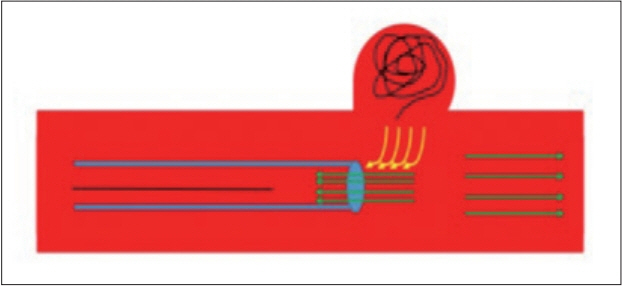J Cerebrovasc Endovasc Neurosurg.
2022 Mar;24(1):58-62. 10.7461/jcen.2021.E2021.03.005.
Acute frame coil migration during filling coil retrieval in a cerebral aneurysm embolization case: A possible result of a venturi effect?
- Affiliations
-
- 1Rambam Health Care Campus, Rappaport Faculty of Medicine, the Technion - Israel Institute of Technology, Haifa, Israel
- KMID: 2527596
- DOI: http://doi.org/10.7461/jcen.2021.E2021.03.005
Abstract
- Coil migration is a known complication of endovascular coiling of cerebral aneurysms. We report an acute coil migration occurring during coiling of an unruptured anterior choroidal aneurysm, while a separate coil was retrieved into the microcatheter concomitantly without direct contact between the coils. The “pulling” of a previously deployed stable coil is presented as an adverse effect that should be noted. This case exemplifies that not only direct entanglement or erroneous malposition can generate acute migration, but possibly, also alteration of physical forces during coil retrieval. A potential mechanism, similar to a venturi effect, caused by a quick suction within the microcatheter at its distal end, is suggested, and the clinical relevance of the case is discussed.
Figure
Reference
-
1. Abdalkader M, Piotin M, Chen M, Ortega-Gutierrez S, Samaniego E, Weill A, et al. Coil migration during or after endovascular coiling of cerebral aneurysms. J. Neurointerv. Surg. 2020; May. 12(5):505–11.
Article2. Abdihalim M, Kim SH, Maud A, Suri MFK, Tariq N, Qureshi AI. Short- and intermediate-term angiographic and clinical outcomes of patients with various grades of coil protrusions following embolization of intracranial aneurysms. American Journal of Neuroradiology. 2011; Sep. 32(8):1392–8.
Article3. Gallitto AA, Zingales R, Battaglia OR, Fazio C. An approach to the venturi effect by historical instruments. Phys. Educ. 2021; Jan. 56(2):
Article4. Grunwald IQ, Papanagiotou P, Politi M, Struffert T, Roth C, Reith W. Endovascular treatment of unruptured intracranial aneurysms: Occurrence of thromboembolic events. Neurosurgery. 2006; Apr. 58(4):612–8.
Article5. Ishihara H, Ishihara S, Niimi J, Neki H, Kakehi Y, Uemiya N, et al. Risk factors for coil protrusion into the parent artery and associated thrombo-embolic events following unruptured cerebral aneurysm embolization. Interv. Neuroradiol. 2015; May. 21(2):178–83.
Article
- Full Text Links
- Actions
-
Cited
- CITED
-
- Close
- Share
- Similar articles
-
- Retrieval of Unintended Migrated Detached Coil: Case Report
- Management of a Complicated Cerebral Aneurysm with Distal Migration of a Detachable Coil: A Case Report
- Manual Aspiration Technique to Retrieve a Prematurely Detached Coil during Cerebral Aneurysm Embolization
- Retrieval of Distally Migrated Coils with Detachable Intracranial Stent during Coil Embolization of Cerebral Aneurysm
- Recent Trends in the Treatment of Cerebral Aneurysms: Comparison between Endovascular Coil Embolization and Surgical Clipping





